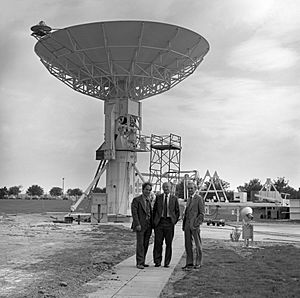Godfrey Stafford facts for kids
Quick facts for kids
Godfrey Stafford
|
|
|---|---|
 |
Godfrey Harry Stafford was a very important British physicist. He was born in 1920 and lived until 2013. He is best known for leading the Rutherford Appleton Laboratories for many years. He also held important roles at St Cross College, Oxford University, and was the president of the Institute of Physics. Dr. Stafford married Helen Goldthorp Clark, an Australian biologist, in 1950. They had a son and twin daughters.
Godfrey Stafford was born in England in 1920. When he was eight years old, his family moved to South Africa. He went to the University of Cape Town. There, he was the top student in his Physics class. In 1941, he earned his master's degree (MSc) by studying cosmic rays.
During World War II, he joined the South African Naval Forces. He was a Lieutenant Electrical Officer. His job involved something called degaussing. This was a way to protect ships from magnetic mines. After the war ended, he went to Gonville and Caius College, Cambridge in England. He earned his Ph.D. in 1950. Later, he worked in South Africa as a biophysicist. In 1954, he moved back to England. He joined the Atomic Energy Research Establishment at a place called Harwell.
Leading the Rutherford Laboratory
The Rutherford Laboratory started in 1957. Gerry Pickavance was its first Director. Godfrey Stafford became the head of the Proton Linear Accelerator (PLA) Group. The PLA was a big machine that helped scientists study tiny particles. In 1959, the PLA successfully created its first full energy beam.
By 1963, the PLA was working very well. Stafford then became in charge of the high energy physics program for the Nimrod (synchrotron). This was another powerful machine for physics research. In 1966, he became the Deputy Director of the lab. He also worked closely with CERN, which is a huge science organization in Europe. He strongly supported the idea of creating a European Physical Society. This society would bring physicists from all over Europe together. In 1969, Godfrey Stafford took over from Gerry Pickavance. He became the new Director of the Rutherford Appleton Laboratory.
During his time as Director, the Rutherford labs grew a lot. In 1975, the Atlas Computer Laboratory joined the Rutherford Laboratory. He also oversaw the creation of a special wire called 'Rutherford Cable'. This wire was super-conducting. It was used to make powerful magnets for future particle accelerators at CERN.
Later Achievements and Honors
After his time at the Rutherford Laboratory, Godfrey Stafford took on new roles. From 1979 to 1987, he was the second master of St Cross College, Oxford. This is a special leadership position at the university. In 1984, he led the European Physical Society. He also became the president of the Institute of Physics in 1986.
For all his important work in science, he received a special honor. He was made a CBE. In 1979, he was also made a Fellow of the Royal Society. This is a very high honor for scientists in the United Kingdom.

